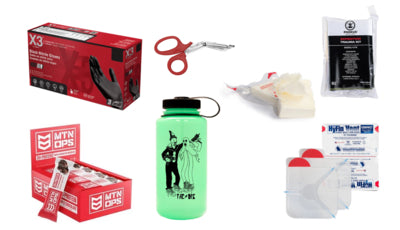Tactical Planning and First Aid Kits

Whether you are exploring the great outdoors or navigating urban jungles, being prepared is the name of the game. That's why we're giving you all the info on tactical first aid survival kits, making sure you're equipped to handle any situation that comes your way. From basic essentials to specialized gear, we’re going to show you how to craft the ultimate first aid kits tailored to your specific needs. Let’s get into some tactical planning!
Common Items for a Basic First Aid Kit
Before we dive into scenario-specific kits, let's cover the essentials that should be in every basic first aid kit. No matter what kick-ass activity you’re building your kit for, you’ll want to make sure you at least have these items:
• Adhesive bandages in various sizes
• Sterile gauze pads and adhesive tape
• Antiseptic wipes or alcohol pads
• Tweezers and scissors
• Disposable gloves
• Pain relievers (such as ibuprofen or acetaminophen)
• Antihistamines for allergic reactions
• CPR face shield or mask
• Emergency contact information
• First aid manual or reference guide
How to Tailor Your Tactical First Aid Kits for Specific Needs
Whether you're honing in on the battlefield or exploring in the backcountry, having a tactical first aid kit tailored to your specific needs can be a real game-changer. Here's how to customize your kit for different scenarios, with a breakdown of the items you need:
Tactical Combat First Aid Kit
In combat situations, injuries can be severe and life-threatening. A tactical combat first aid kit is designed to address these critical injuries quickly and effectively. Here are some essential items to include:
• Tourniquets: Used to stop severe bleeding from extremity wounds, tourniquets are crucial for preventing exsanguination (blood loss) in combat situations.
• Hemostatic Agents: These specialized dressings contain clotting agents that promote rapid blood clotting, essential for controlling hemorrhage from deep wounds.
• Chest Seals: Used to treat open chest wounds (or stab wounds), chest seals prevent air from entering the chest cavity, reducing the risk of tension pneumothorax.
• Trauma Shears: These heavy-duty scissors are used to cut through clothing and gear to access and treat injuries quickly.
• Israeli Bandages or Emergency Trauma Dressings: These pressure bandages are designed to apply direct pressure to wounds and control bleeding effectively.
• Nasopharyngeal Airway (NPA): Used to maintain an open airway in unconscious or injured patients by inserting it into the nasal passage to prevent obstruction.
• Combat Gauze: This specialized hemostatic dressing contains clotting agents and can be packed into deep wounds to control severe bleeding.
Field and Range First Aid Kit
For outdoor enthusiasts, especially those involved in shooting sports, a field and range first aid kit is essential. This kit is designed to address common injuries encountered during outdoor activities and shooting practice. Here's what to include:
• Wound Dressings: Sterile gauze pads, adhesive bandages, and adhesive tape for covering and protecting minor wounds and abrasions.
• Burn Gel: In case of burns from hot firearms or cooking equipment, burn gel provides relief and promotes healing.
• Eye Wash Solution: For flushing debris or contaminants from the eyes, especially important in dusty or windy outdoor environments.
• Splinter Forceps: Tweezers with a fine tip for safely removing splinters or foreign objects embedded in the skin.
• Blister Cushions: Moleskin or blister pads to prevent and treat blisters caused by hiking or wearing uncomfortable footwear.
• Insect Sting Relief: Antihistamine creams or wipes to relieve itching, swelling, and discomfort from insect bites and stings.
• Field Dressing Supplies: Include bandages, wraps, and tape for stabilizing more serious wounds until medical help can be reached.
Hunting First Aid Kit
Hunting often takes us into remote and rugged environments, where access to medical assistance might be a little limited. That’s why a hunting first aid kit is designed to address injuries specific to hunting activities. You’ll want a:
• Snake Bite Kit: A venom extractor pump and antivenom medication for treating snake bites encountered in the wilderness.
• Emergency Whistle: For signaling for help in case of emergencies or getting lost in dense woods.
• Folding Saw or Multi-tool: For cutting branches or clearing brush to create a clear path or shelter in the wilderness.
• Field Dressing Supplies: Including gloves, antiseptic wipes, and bandages for treating injuries sustained during field dressing of game.
• Emergency Blanket: Reflective emergency blankets provide warmth and shelter in case of exposure to cold temperatures or hypothermia.
• Navigation Tools: Including a compass or GPS device to aid in navigating back to civilization if lost in unfamiliar terrain.
• Water Purification Tablets: For purifying water from natural sources to prevent dehydration in emergencies.
Extreme Cold Weather Kit
In cold-weather environments, the risk of hypothermia, frostbite, and cold-related injuries is definitely heightened. An extreme cold weather kit is essential for staying safe and warm in these conditions. You’ll want to make sure you have these:
• Hand Warmers: Disposable hand warmers provide instant heat and comfort in cold weather conditions.
• Thermal Blanket: A lightweight, compact thermal blanket reflects body heat back to the user, preventing heat loss and providing insulation.
• Cold Compress Packs: These single-use packs provide instant cold therapy for treating injuries such as sprains or strains sustained in cold-weather environments.
• Frostbite Prevention Supplies: Including insulated gloves, hats, and socks to protect extremities from frostbite.
• Emergency Shelter: A lightweight, portable shelter such as a bivy sack or emergency tent protects from wind and precipitation in case of emergency.
• Snow Goggles: Protect eyes from snow glare and wind exposure, reducing the risk of snow blindness and eye irritation.
• High-Calorie Snacks: Energy bars or high-calorie snacks provide quick energy and warmth in cold weather conditions.
Urban Emergency Kit
In densely populated urban environments, emergencies can range from natural disasters to man-made crises. Because of this, an urban emergency kit is essential for navigating these scenarios safely. Here's what to include if you want to be prepared for anything:
• N95 Masks: These masks filter out airborne contaminants, including smoke, dust, and airborne pathogens, protecting the wearer's respiratory system in polluted or hazardous environments.
• Trauma Shears: For cutting through clothing or seat belts to access and treat injuries quickly.
• Glow Sticks: These light sources provide visibility in low-light conditions or power outages, aiding in navigation and signaling for help.
• Pry Bar or Crowbar: For accessing blocked or barricaded areas in emergencies, such as collapsed buildings or locked doors.
• Emergency Radio: A battery-powered or hand-crank emergency radio provides access to news updates, weather alerts, and emergency information during power outages or communication disruptions.
• Emergency Contacts and Documentation: Including copies of important documents such as identification, insurance information, and emergency contacts in a waterproof container or bag.
• First Aid Manual: A comprehensive first aid manual or reference guide provides instructions for treating common injuries and medical emergencies encountered in urban environments.
